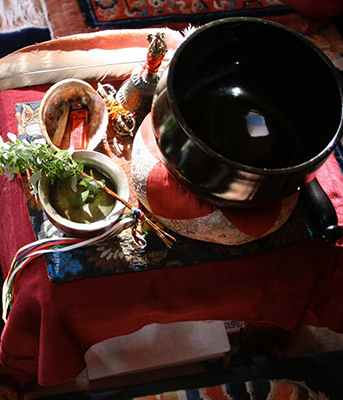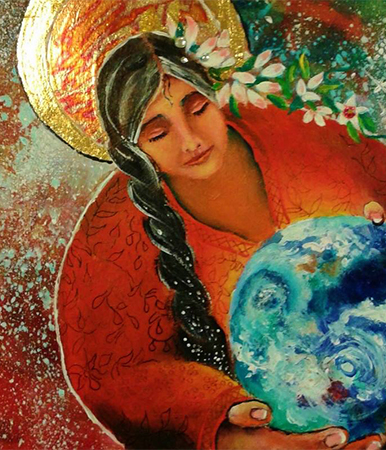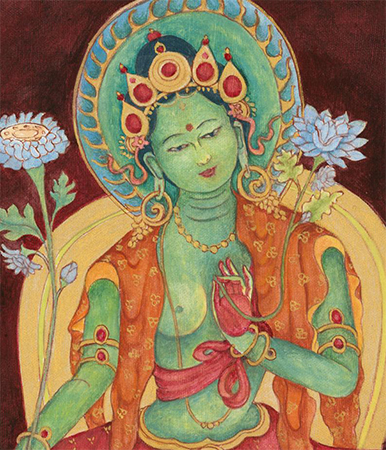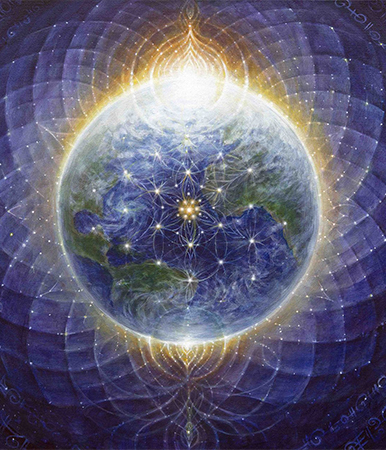GAIA MANDALA
GLOBAL HEALING COMMUNITY
Earth Treasure Vase for Fukushima, Japan
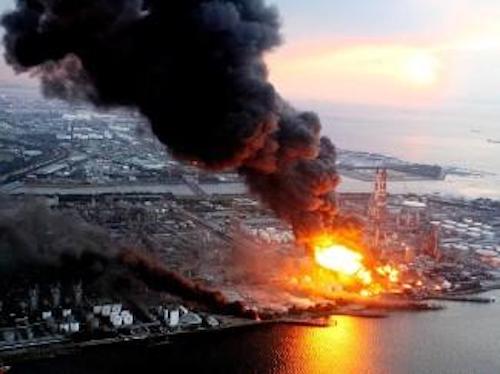
Introduction
The Earth Treasure Vase for Fukushima in Japan was requested and stewarded by an American, Stephen Comee, who has been living and working in Japan since 1974, where he works for the Japanese Ministry of Foreign Affairs, in a semi-governmental branch that promotes intercultural exchange between Japan and the rest of the world.
Stephen has been practicing Tibetan Buddhism since 1976 and in 1979 became a ngakpa under H.H. Ngawang Tenzin Zangpo Rinpoche at Thyangboche Monastery in Nepal. And then in 2007, he became a Buddhist priest in the Japanese version of Vajrayana, called Shingon (meaning ‘’mantra’’). In 2010 he underwent a 100-day intensive training and received the abhisheka initiation of the full transmission of the Dharma and was made an Acharya (Ajari in Japanese) which is a Vajra Master with the certification to teach the Dharma, in which capacity he has performed healing ceremonies around the world.
When Stephen attended his first Full Moon Meditation he was very moved by the meditation and the story shared by Dahr Jamail, who told of his journey to bring an Earth Treasure Vase to Utiagvik, Alaska.
Stephen writes:
“I very much enjoyed the beautiful meditation and strongly felt the light being sent to, and then from, all of the Earth Treasure Vases around the world. I could also feel the power of all the people—the circle was so strong, as if we enveloped Gaia herself in a protective cloak of light and healing. After listening to Dahr and experiencing the meditation, I was moved to write to Cynthia and ask if I might steward a vase. When Cynthia’s positive reply arrived, I was ecstatic!”
Stephen intended to plant the vase he requested near the site of the nuclear meltdown disaster in Fukushima that resulted from the enormous earthquake and tsunami of March 11, 2011. The nuclear power plant has poisoned Japan (by covering the land with plutonium dust and possibly cesium as well) and the Pacific by leaking much radioactive material into the sea—and, despite denials by the government, it is still leaking. This one disaster continues to heat up the seas in the north Pacific (as evidenced by NASA’s infrared and photography of the area) and change weather patterns drastically, contributing to global warming. The situation is so critical that radioactive fish have been found on the western coast of the US (as reported in several west-coast newspapers at the time).
The vase was dedicated to bring purification to the land and the sea in this region – and for the land to once again be usable and the polluted ocean clean. At the time of stewarding the vase, there was a strong conflict between the US and North Korea, with Japan caught in between. This added to the priority to bring an Earth Treasure Vase to Japan.
Stephen wrote:
“After being selected as an Earth Treasure Vase Steward, I had to overcome the hurdle of how to get the Earth Treasure Vase to Japan as they are ideally to be passed “warm hand to warm hand.” I was grateful when the Universe manifested a friend who offered to carry the vase from the US to Japan. Doni Amoris, who was returning to Japan after visiting his family in Alexandria, VA, served as the Vase Bearer, very carefully bringing it to me in Japan and hosting the first full moon meditation with the vase in his beautiful home-temple in Tokyo.”
That full moon was a Super Moon, a Blue Moon and a Blood Moon. The full moon ceremony was performed by three men and three women, all either Buddhists or healers. Stephen performed a special ritual to re-consecrate the vase, replacing the many items that had been placed inside by Cynthia and the Gaia Mandala Sangha and which had been removed to facilitate international travel. During the time it took to slowly replace the items with prayers, the group chanted the Heart Sutra in Japanese. The Heart Sutra is one of the most well known sutras in Mahayana Buddhism, and it explains the fundamental emptiness of all phenomena and includes the famous statement of Avalokiteshvara that ‘’Form is Emptiness, and Emptiness is Form.’’ This fundamental Buddhist teaching points to what late Zen master Thich Nhat Hanh calls the reality of inter-being*. After reciting the Heart Sutra the group joined with the global mandala to practice the Earth Treasure Vase Meditation together.
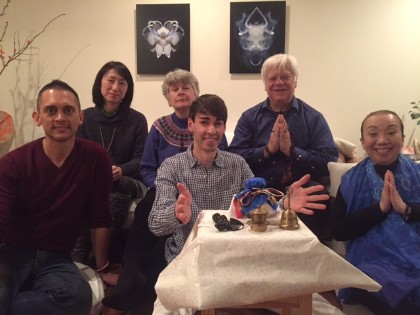
Stephen Comee, back right, Doni Amoris, front center, and Toyko friends with Fukushima
Earth Treasure Vase during January 31st Supermoon Eclipse.
Stephen:
“As soon as we started, we could all feel the connection with the grid created by the Earth Treasure Vases already buried all over the world. Three of us put other sacred items into the vase, and all of us offered prayers and placed our intentions inside the vase that Gaia be blessed and healed. The room seemed filled with a warm, radiant, and expansive light. Other friends from around the world also sent their prayers to the vase. I named our group the Indra Net Sangha—a metaphor used to illustrate the concepts of Emptiness, Interdependent Origination, and Interpenetrating Connection of everything in existence.”

Planning of the Burial
The vase was planned to be buried on July 6 but had to be postponed due to a typhoon, torrential rains and landslides. The newly agreed date was the morning of July 27. This was a lunar eclipse day, which is a very auspicious day according to the Tibetan calendar. On such a lunar eclipse day the merit accrued is multiplied 100,000 times.
Besides that, the 8th and 15th days of each month are dedicated to the Medicine Buddha. Within Tibetan cosmology, this was an Earth-Water day, which is considered auspicious for this reason: “The encounter of earth with water brings youth, which brings happiness.’’ So one could say that this constellation of elements made the chosen burial date a rejuvenation ritual for the Earth. The last auspicious factor was that it was a Sojong (healing and purification) day and confessional practices done on this day “fully restore all positivity, and clear away all negativity without exception.”
The 27th of July happened also to be the day that the late Rev. Kobayashi would have turned 70. Acharaya Kobayashi had been an important mentor to Stephen and to the two other Shingon priests, who joined the burial ceremony.
Before the date of the burial had changed, in anticipation of burying the vase on July 6, on the 4th of July, Stephen placed the last gift into the vase and sealed it with the cork permanently. Then he added the five-colored silks and tied the five-colored cord around the neck to hold them in place. In lieu of sealing wax, which he did not have, a special amulet from the shrine of a Japanese Yin-Yang master from a thousand years ago was used. It is a white pentagram on which is inscribed a white pentacle—the number five indicating the five elements: metal – water – wood – fire – earth.
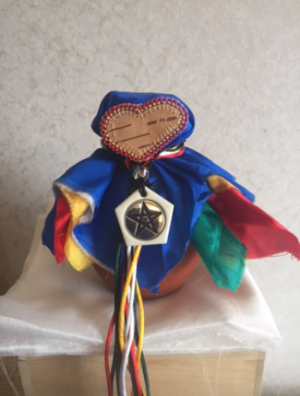
Fukushima vase sealed with five elements amulet and birch bark pin.
Stephen shared:
“I used it in order to invoke all five elements to not only protect the vase, but also to all work together toward the healing of Gaia. Then, above that, I attached a birch-bark pin given by a New England Native American friend; it is heart shaped, and by using it I hope to touch the hearts of all to take better care of our home, to open the hearts of all to peace, and to soothe Gaia’s aching heart.”
Then the Vase was wrapped in a pure white silk kata scarf and in a tenugui cloth with a Mayumi Oda print of the Medicine Buddha (which Cynthia Jurs had sent with the vase). All of that was wrapped in a beautiful scarf designed and donated by Doni Amoris (who kindly carried the vase to Japan) that he imbued with the energy of the Amaterasu, the Japanese Sun Goddess, and that is named “Divine Light.”
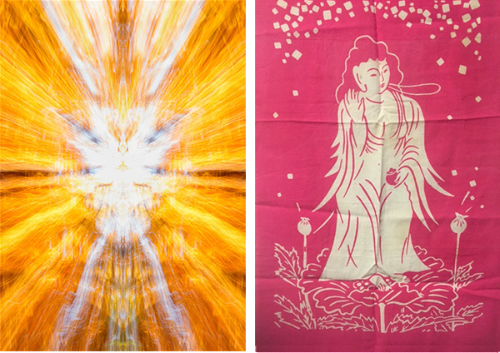
The ETV was wrapped in this silk scarf of “Divine Light” imbued with the energy of the Amaterasu, the Japanese Sun Goddess by Doni Amoris (left) and Mayumi Oda’s tenugui Medicine Buddha Goddess cloth (right ).
In the bottom of the box, some sacred sakaki leaves and small cedar boughs were placed. The vase was nestled into these and the rest of the box was filled with more leaves and cedar branches, dried flower petals from Cynthia, plus some offerings that would not fit into the Vase itself, such as a small abalone shell and a novaculite arrowhead.

The Burial Ceremony
by Stephen Comee
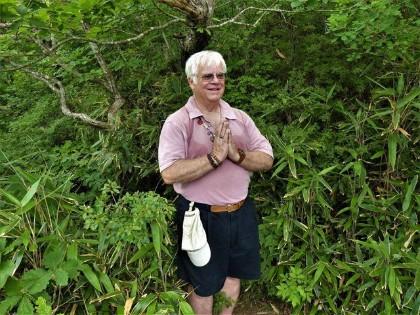
Stephen Comee at the day of the burial
‘’The date of July 27 was finally set for a group of four of us to carry the Earth Treasure Vase forth and bury it. However, a few days before, the Japanese weather agency announced that Typhoon Jongdari (No. 12) was scheduled to hit Japan at around that time! I prayed to the weather devas and dakinis and requested that the rains not hit the Fukushima region until the 28th. In the end we were blessed with good weather: partly cloudy and only 80° F, instead of the 90° F that we had been having for 2 weeks.
Being cooler would make the climb easier and, as we discovered, underneath the trees that covered the path much of the way, the breeze did feel cool. We filled our bottles with water and got into our rental car, set the navigation and drove off. But as we could not manage to set the navi to the exact spot, we had a little trouble getting there. With the help of a kind old woman who worked as a gardener at the nearby Children’s Camping Ground, we easily found our way to the parking lot at the foot of the mountain, where the hiking trail up the mountain above Fukushima begins. We were very pleased to see that there were no other cars in the parking lot, so we hoped we would have the mountain all to ourselves.
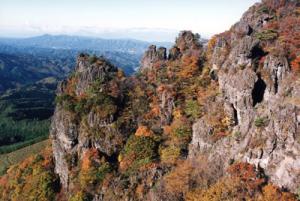
Mt. Ryosen, the mountain where the Vase was buried.
We said a short prayer and asked for permission to enter the mountain, and then took up walking sticks provided for hikers there, and set off. The group consisted of myself; two fellow Shingon-sect priests, Acharya Mr. Shin’ichi Itten Takahashi (Mr.) and Rev. Ms. Mika Kōsui Nogoshi (Ms.)—both of whom had been students of the late Acharya Sōjirō Shūhō Kobayashi (Mr.) with me; and a very spiritual friend, Mr. Ken Miyamoto, who is most knowledgeable about mountains and sacred spots throughout Japan and who was quite familiar with this mountain. It was Mr. Miyamoto who informed me that this mountain is a pivotal spot: he told me that if we bury the Earth Treasure Vase here, it will not only help heal Fukushima and the Tōhoku (northeastern) region of Japan, but will go on to help heal all of Japan, East Asia, and all of Gaia Herself!
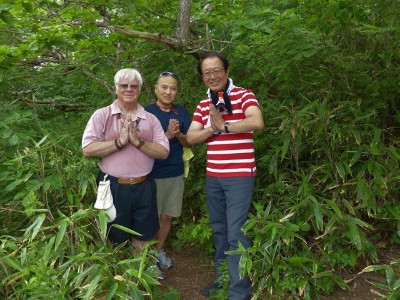
We made a few stops along the way up, first taking in the beautiful view from the Observation Rock. We passed the place where tengu (mountain spirits) are said to have practiced sumo wrestling, and proceeded to climb up to the Gomadan (Rock Altar for Fire Ceremonies), an incredible natural formation, where we sat and recited the Heart Sutra three times, followed by some Shingon mantras and prayers. While we were praying, I felt three “presences” pass behind us and continue up the path, but thought no more about it.
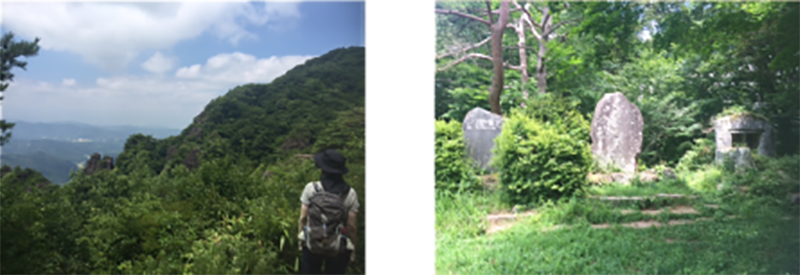
Right:The medieval memorial site
We continued climbing, sometimes over rather treacherous terrain where chains and ladders had been installed to help hikers—the path that led up to the Rock Altar is so dangerous that it is called “Path Where Parents and Children Forget Each Other Out Of Fear”! Soon we found ourselves in a large opening. Our path had ended.
There were three possibilities on the opposite side of the field, where we found ourselves. We weren’t sure which way to go. The field indicated the spot where a small medieval castle had once stood, and where there was a memorial to Imperial Prince Noriyoshi (1328–68, later Emperor Go-Murakami, r. 1339–68), who once traveled as a young child (1333) to this part of Japan with a force sent to defeat the warriors of a rival faction. To the right of his memorial was a small shrine in which many people have left prayers written on small boards. When we went to read the inscriptions, we noticed three old men (the same three beings I had sensed earlier?) sitting down and talking over rice wine and snacks. I remember thinking that they reminded me of Taoist immortals—but I think they were physical, because the others saw them, too. We apologized for bothering them and had no other interaction with them. I did, however, overhear one of them say to his companions, “That path leads to the highest point on the mountain.” I looked toward where he pointed and saw the path.
Suddenly I knew that we had to go that way. So we drank some water and ate some dried fruit that Mika had brought, and climbed up to what was called the “Eastern Watchtower,” which represents the highest point of the mountain. On the way, we saw a dead hawk lying on the path. Some animals had eaten most of it and there were feathers everywhere. I was going to take some to add to the burial site, but was guided not to. Instead, I said a short prayer for the liberation of the hawk’s soul, and we continued on.

With a little difficulty, we climbed up a huge boulder by holding on to a chain and made it to the top, but I was dismayed to see that the summit was a very rocky outcrop. It seemed that there was nowhere to bury the vase in the ground, and also no fissures in rocks or caves in which we might hide it. I could hear voices approaching, so we sat for a bit, when all of a sudden the same three old men appeared. We all nodded to one another, but no one spoke. There was a boulder that represented the highest point, and one of the men jumped on top of it and spread his arms like an eagle, then he jumped off and all three left by taking a path I had not noticed. They disappeared as quickly as they had arrived, leaving us wondering if we had actually seen them. Itten said what I was thinking—that maybe they were trying to show us something and we should investigate that area.
Whether these three beings were: a) deities or spirits living on and protecting the mountain; b) immortals who helped those on the mountain; c) normal human hikers who just happened to be in the right places at the right times; or d) none or all of the above, doesn’t really matter. What is important is that they led us to finding the perfect spot! We had also noticed that yellow butterflies kept appearing and pointing the way for us. We realized that butterflies are signs of transformation, of something being in the process of changing, of coming to a new life, and yellow butterflies indicate that one will meet a spiritual master. I like to think that those three beings were our spirit guides for the day. . . .
After they left, I walked a little way down the path they had taken and noticed that there was lots of brush and undergrowth as well as several red pines and other trees. When I peered into the brush, I noticed that there was one tree in particular—a small red pine—that had a secondary trunk growing very close to the ground and thad had a small space beneath it. We all knew immediately that it was the right spot and decided to bury the vase there. We dug a hole deep enough to bury the box containing the Earth Treasure Vase, which I had encased in copper sheeting for burial, securely in the Earth.
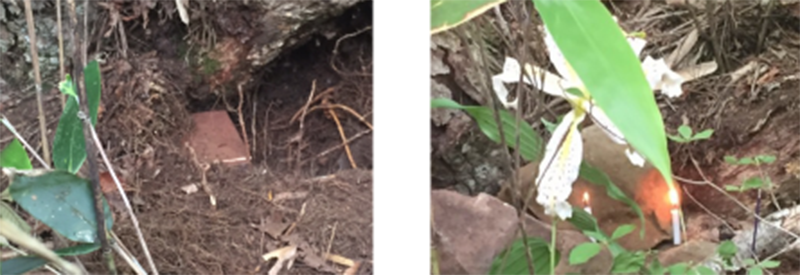
As Itten was digging the actual hole, I performed the burial ritual I had written, based upon Japanese and Tibetan prayers and traditions. The Earth Treasure Vase seemed very happy not only to be sitting in the bosom of Mother Earth but also to be embraced by Granny Pine. We replaced the soil and broken roots, and packed it down tightly, after which we positioned several medium-sized rocks to hold the soil in place and prevent erosion from rain. I saved some of the soil for Cynthia, so that she might add small bits of it to future vases. When we were done, and the burial was complete, we lit two small candles and put them on each side of the spot, lit a stick of incense, and offered a wild mountain lily, placing it in the ground above the vase. Then we once more recited the Heart Sutra, followed by something called the Mantra of Clear Light and a few other mantras. When finished, we all stood briefly, extinguished the candles and removed them, and placed the incense upon a stone until it burned out.
It was interesting that as we dug, we kept pulling glass bottles out of the ground—some whole, some broken—that once contained Coke, beer, and even whiskey. We dug up about a dozen of them. We could tell that they were very old; by shape, as well as by depth, we guessed that they must have been discarded by climbers some forty or fifty years ago. It felt as if each time we took one out of the Earth, the ground seemed to sigh with relief. We carried them down the mountain, and I discarded them in a recycling bin upon returning home.
On the way up the mountain, sometimes my backpack, which contained the vase, felt very heavy. I could not tell if it was because some forces were trying to prevent us from succeeding in our mission, or because it was such an important task we were doing, but because of the weight I felt quite fatigued and shared the carrying of the Earth Treasure Vase with Itten, who helped carry it to the summit. We both felt the “weight” and it seemed fitting, that after bearing this sacred offering up the mountain, he dug the hole while I said the prayers and performed the ritual I had written for the burial.
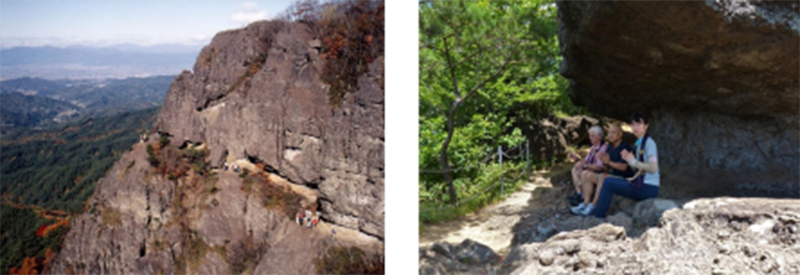
The path to Gomadan & praying under the overhang – Mika is praying with Shun’ichi & Stephen
Upon leaving the site and beginning our descent, we suddenly found ourselves looking at what is called the Rock of Learning. It is a large overhanging part of the mountain that forms a womb-like area beneath it that is directly below the burial site. Being mostly Shingon priests, it seemed to us as if the site at the summit on top of the overhang is the Diamond Realm, or the world of spirit, and where we were standing beneath the overhang was the Womb Realm, or the physical world, the place from which all Earthly phenomena are born. This gave us reassurance that we had indeed found the proper spot for the vase.
As we were descending, suddenly Mika stopped and said, “Look! There’s a snake!” It struck me as most bizarre, since I had just said, “Oh, I really hope we don’t see a snake on the way down!” I had forgotten that telling the Universe that you don’t want something has the same effect as asking for what you do want! It was slithering through the ground cover, and in an opening in the leaves I could see about 8” of its body. But it was moving rather swiftly and as I watched it go by I could count to 5, so I supposed that it was at least 4’ or more long. The body was thick, about 1.5” in diameter. Thinking I knew what kind of snake it was, the length indicated that it was a female; and the girth suggested that it might be pregnant. Its scales and striped pattern flashed with iridescence when the sunlight hit it, much like a rainbow trout.
Mika was getting close to observe it, but thinking that it was venomous, I suggested that she not surprise it and that we should all move back and thank it for blessing us with its presence. (I found out later it was a Tiger Keelback [Rhabdophis tigrinus], a type of venom-bearing colubrid commonly found in Japan’s mountainous areas.) Spiritually, snakes are connected to life force and primal energy as well as transformation. In Japan, they are also seen as messengers of the gods.
So we were certain that the gods of the mountain had sent the serpent to thank us for burying the vase and for our reverence and also to give us their blessings and to confirm that transformation would result from the burial. It was interesting to note that the snake was also descending the mountain, almost as if leading us down and seeing us off. Humbled and blessed, we left the mountain and found our vehicle. For me, the rain did not start until I reached my home near Tokyo, about six hours later. And only seventeen hours after the actual burial, I was on a call with Cynthia and the global Earth Treasure Vase community, still shaking with exhilaration, giving a shorter version of this adventure!
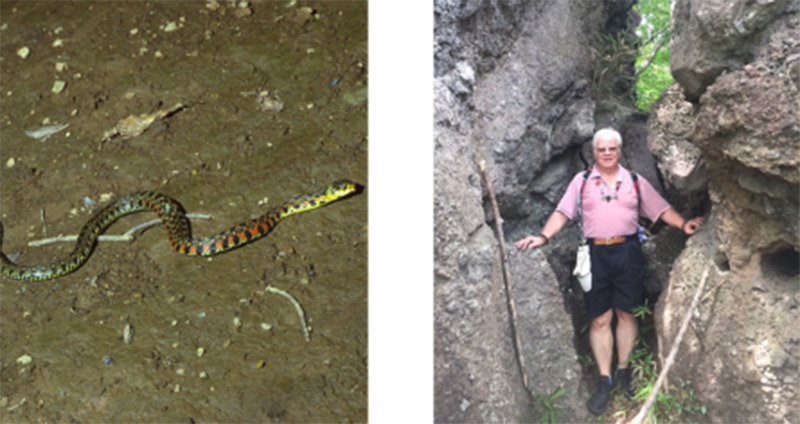
One thing I told Cynthia after the full moon call is that when we were burying the vase, I was moved to bury with it all the things that stood in the way of my taking the next step of being a vessel of light myself. It seemed in many ways that the Earth Treasure Vase and I had not only connected, but joined: the vase was in the Earth doing its thing, and I was on the Earth doing my thing. And one of the things I feel compelled to do now is to simply radiate the power of the Vase, the power of the Light, so that all who pass near me may feel its blessing. It is a very humbling experience, but one that I am enjoying. I can only give thanks for having been given the sacred opportunity to serve as steward for one of these incredibly powerful Earth Treasure Vases. It even feels as if burying the Vase was one of the reasons that I reincarnated again at this time and live in this place.’’
E ma ho! A la la ho!
Excerpt of a Special Liturgy for the Earth Treasure Vase Burial
Stephen Comee wrote a special liturgy for the Earth Treasure Vase burial. This is an excerpt:
Calling Upon All Beings of Light to Protect This Site Forever
I bury this special Treasure Vase for the spontaneous healing of the Earth:
May all karmic debts be purified, and may all beings attain buddhahood!
May illness, harmful influence, obscurations, and impurities be purified!
May all discrimination, all plague, famine, and warfare be pacified!
May all man-caused pollution be neutralized, both land and seas cleansed!
I call upon all ḍākinīs, dharmapālas, wrathful protectors, and others
To protect this vase and repel all who attempt to dislodge it from the Earth.
May all inauspicious bad omens for Japan and for the world be averted!
May the radioactivity released by the Fukushima accident be cleansed,
That the Earth and all that dwell thereon may be free of all suffering.
May all planetary forces, nāgas, demons, arrogant king-like spirits,
All who wish to bring harm or to cut short the breath of life, be repelled!
May the eight great fears and sixteen lesser fears be overcome!
For me and all those around me, may all that is inauspicious be averted!
May the powers and strength of samaya-breakers and demons be averted!
May all bad omens for this Vase, Earth, and all sentient beings be averted!
Oṁ Āḥ Hūṁ Samaya!
Closing Prayer
As long as afflictions beset the Earth and her sentient beings,
May this Earth Treasure Vase be the doctor,
The medicine, and also the nurse
Who restores them to health.
. . .
For as long as the Earth remains,
For as long as sentient beings remain,
Until then may this vase too remain
To dispel the miseries of the world.
(based on Bodhicaryāvatāra, 3; 10)
Footnotes
* There are many insightful books about the Heart Sutra. One of those is the commentary by Thich Nhat Hanh: The Other Shore – A New Translation of the Heart Sutra with Commentaries.

